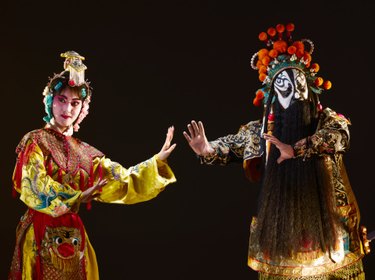
Cults dedicated to the anciet Greek god Dionysus first created masks for theatrical productions. They used masks for many different reasons, primarily for quick character changes. Female masks let men play women's roles, since women were not allowed to perform on stage. You have many options when creating ancient Greek masks for children, ranging from simplistic theater masks to masks modeled on prominent figures in Greek mythology.
Theater Masks
Video of the Day
Greek theater masks were crafted with distinct expressions, allowing for visual communication to supplement to speech and storytelling. These masks were typically made of wood, leather or cloth and decorated with hair. Crafting Greek theater masks gives children a great outlet for creativity and personal flair. They can create a variety of distinct expressions by changing the shape or contours of the mouth, eyes and nose. Add decorations like paper, glitter and beads to personalize a theater mask and make it show the child's distinct personality.
Video of the Day
Greek God Masks
Masks of Greek gods can teach children about Greek mythology and help them recognize distinct traits of the Olympian gods. Masks using a paper or paper mache base can be decorated with distinctive features of the gods. For example, a mask of Aphrodite, the goddess of beauty and love, could include a heart, an indication of her power, and objects like seashells or feathers, which are her symbols. Dionysus might inspire a mask adorned with fake ivy or small pine cones, while a Poseidon mask might be painted with ocean-tones and decorated with long, blue hair. Making Greek god masks can lead to unique and creative results while still being educational.
Hero Masks
Greek heroes, like Greek gods, have distinct characteristics that can be creatively interpreted in a child's mask. For example, a mask of Hercules could include drawings of serpents or snakes, referencing the snakes he killed as an infant, foreshadowing his special abilities. A mask of Odysseus might include references to the Trojan horse, which he was famous for leading into the city of Troy, leading to its destruction and the end of the Trojan war.
Monster Masks
Greek mythology is filled with monsters, beasts and mythical creatures that offer the highest potential for creativity in children's masks. These masks can vary significantly in shape, uses of mixed media and methods for construction. For example, a mask could be made to represent Cerberus, the three-headed dog with a giant mane which guarded the gates of the Underworld. This would contrast greatly against a mask of an Empusa, a flame-haired vampiric demon, or a Minotaur mask, which would resemble the head of a bull. Craft supplies for a Greek monster mask could include objects like feathers or faux fur.